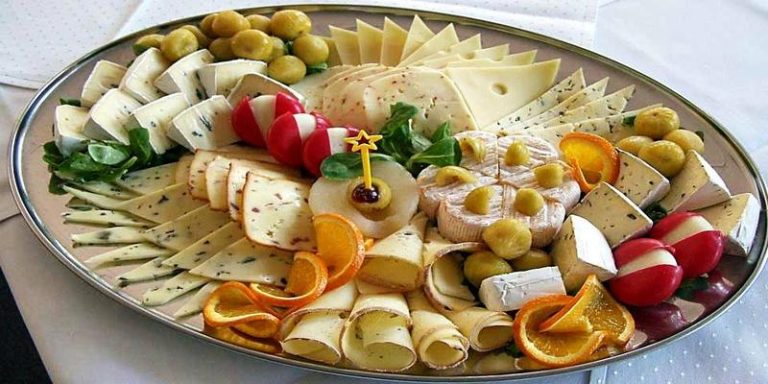Stocking your kitchen pantry with cheese for your next culinary adventures? Then check out the following types of cheese that would be best for many types of dishes:
Table of Contents
Cheddar
We list this first, because it’s one of the most versatile cheeses out there. You can use it for a wide range of dishes.
You can start with a cheese pimiento sandwich, by combining cheddar cheese with pimento pepper and mayonnaise. You can go with regular cheese sticks, or be more daring with “dynamite” cheese sticks, which are long green chilis stuffed with cheese.
It works with other types of cheeses as well. Cheddar’s slight saltiness and sharpness mixes nicely with the mild and soft mozzarella, the hardier Monterey Jack, and the nutty fontina cheese.
The cheddar cheese also works for mac and cheese balls. Just make your regular mac and cheese, but don’t eat it yet. Instead, set the mac and cheese into small ball-sized portions, and freeze these portions overnight. Then deep-fry these portions for your bite-sized mac and cheese balls, which will be great when served with marinara sauce (or some other tangy sauce).
Feta Cheese
This is a crumbly type of cheese that’s made from sheep’s milk or goat’s milk, or even both. It’s brined, which explains why it’s salty. As it’s both salty and tangy, feta cheese is your ideal choice if you’re making Mediterranean dishes. It goes nicely with grilled meats and fresh veggies.
Basically, you can add some feta cheese to a simple dish and turn it into something a bit fancier. Just add some blended, cubed, or mashed up feta cheese and dishes like tuna becomes even better.
Cream Cheese
Before we get entangled on what “real” cream cheese is, let’s just go with the US FDA definition. Cream cheese is a cheese product that has at least ⅓ (33%) milk fat. But that’s not all. Its moisture content should be 55% at the most, while its pH range is within 4.4 to 4.9.
This cheese isn’t naturally matured, so it’s best to consume the cheese right away after you open it package.
This is the cheese you want if you like making cheesecakes, like our favorite New York-style baked cheesecake with blueberries. You also need cream cheese for red velvet cupcakes and carrot cakes.
To use cream cheese right, you need to use a lot of it so you can get a rather thick consistency. Don’t scrimp and go with the cream cheese with the higher fat content, especially if you’re making desserts, pastas, and dips.
Blue Cheese
This type of cheese gets its name from the blue (or blue-green) spots on the cheese. These spots are also responsible for that strong smell that blue cheese is famous for. Some cheese newbies aren’t all that fond of blue cheese at first glance, due to the spots and the funky smell. And it doesn’t help when they learn that those spots and the pungent smell is due to a fungus (Penicillium).
Those in the know, however, are quite aware that this is an edible fungus. And many cheese fans actually like that rather funky taste that matches the pungent smell. It’s also a versatile cheese, as you can pair it with other strong-flavored ingredients like cayenne pepper sauce, or you can blend it with the milder cream cheese.
Blue cheese works great with beef stroganoff, along with other dishes that use buffalo wings and other similar stuff. That’s due to the deep umami flavor you can get from the cheese.
Paneer
Paneer is a type of cheese made from buffalo or cow milk, set with a fresh acid like yogurt or lemon juice. It’s very popular in the South Asian countries such as India, Pakistan, and Bangladesh. It resembles cottage cheese somewhat, although with paneer the cheese curds are completely separated from the whey.
Paneer cheese is a very popular option for many hearty vegetarian dishes in South Asia. In fact, if you’re going meatless, then you can always just add some paneer cheese for flavor to go with your steaming basmati rice.
Brie
This is a soft and mild cheese that works well withs savory dishes and fruit-based desserts. If you’re a cheese newbie, don’t forget that the waxy white casing that brie comes in is also edible, and you can use it for some dishes.
This cheese goes nicely in sandwiches, pasta dishes, and salads. You can be very creative as well, such as putting some brie cheese, sliced tart apples, and rich caramel sauce on bread. And it’s terrific as part of your dessert dish, too.
Gruyere
This is a fancy type of cheese that’s very popular in Europe, especially in Switzerland where the cheese comes from. The age of the cheese determines its flavor, but it’s easy enough to find gruyere with the somewhat complex, grainy, and bitter notes you’re looking for.
It goes well with salads and sandwiches, and you can eat gruyere with your grilled sausages, which is great with beer.
Even if you’re not really much of a cook, then at least you know the different types of cheese. Next time you go to Bahama Breeze and pay $5.79 for Breeze Cheese Bites, find out what cheese they’re using, and check if it makes a difference if you go with another type of cheese!
Gruyère, Mushrooms & Eggs #Shorts

